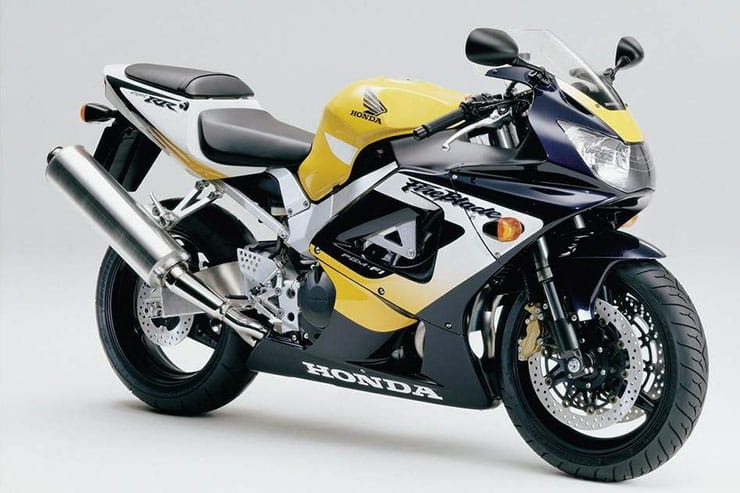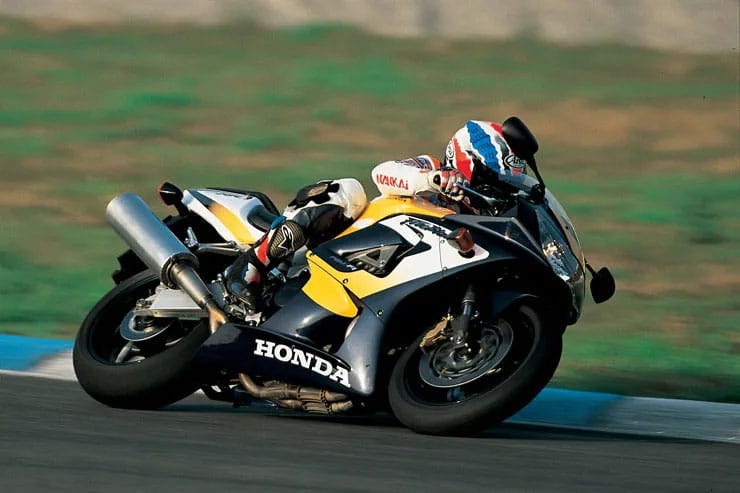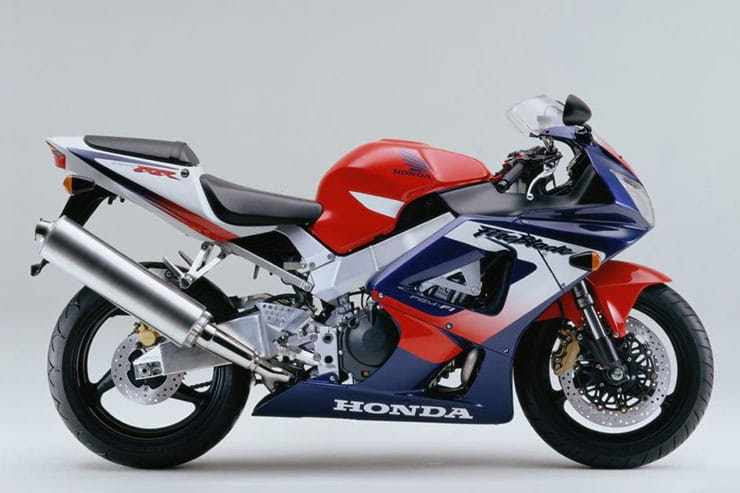Honda CBR900RR FireBlade (2000-2001): Review & Buying Guide
By Jim Moore
Bike journo for a quarter of a century
04.05.2023
Price: £2500-£5500 | Power: 150bhp | Weight: 197kg | Overall BikeSocial Rating: 3.5/5
Honda made a massive leap forward with its original 1992 FireBlade. So much so, for six years straight the Big H had the litre superbike class all to itself. But then in 1998, Yamaha’s YZF-R1 crashed the party and made the CBR look ancient overnight. Honda’s response took two years to surface. Although lighter (by 8 kilos), more compact (5mm shorter wheelbase), up on cubes (by 11cc) and more powerful (by a claimed 20bhp) than the previous FireBlade, the 929 Honda was still down on capacity against the Yamaha. And in terms of styling, Tadao Baba’s Y2K Blade looked positively conservative next to the R1.
There were issues right off the bat, too. Baba-san shunned carburettors, favouring fuel-injection for his new CBR. This proved to be a mistake given the rudimentary nature of the then PGM-FI system. Throttle response could be erratic, imprecise, and unsettling – not something anyone wants on a 150bhp motorcycle. Well, I say 150bhp; Honda claimed that in order to compete with the R1, but the rear wheel measured reality was closer to 125bhp.
Handling wasn’t as good as it could have been either. Contemporary tests talked of a stiff feeling chassis (not surprising given the massive beam frame and chunky gearbox-mounted swingarm that looked like it’d been pinched off an RCV GP bike) coupled with poor quality damping characteristics and a propensity for the bike to feel nervous and excitable over anything less than billiard table smooth surfaces. All of which impacted sales and necessitated the appearance of the much improved 954 model just two years later.
But that was then. This is now. Some 20-plus years on we’ve learned how to iron out the 929’s faults and unlock the potential of a bike that should have made Baba-san far prouder than it did at the time. Poor fuelling and throttle response are easily rectified with a power commander and removal of the airbox’s bleed valves and secondary air flaps that do more to restrict air intake than promote it. Binning the exhaust system’s H-TEV valve also speeds the passage of exhaust gasses.
Fixing the chassis is equally straightforward. Revalved/resprung forks and a quality shock (Öhlins/WP/Maxton etc) make a night and day difference to the 929. If those things have not already been addressed, they really should be given the fact that suspension that’s not very good when new will be bloody awful by now.
Add to that the 929’s attractive pricing (tidy examples can be had from as little as £2500) and it’s not hard to see why this often-forgotten member of the FireBlade dynasty is now well worth a look, particularly if the predictable R1/GSX-R path is not for you. Here’s now to bag a brilliant Y2K FireBlade.
Honda CBR900RR FireBlade (2000-2001) Price
The 929 is a forgotten model in the FireBlade story, partly because it only lasted two years before being replaced by the far superior 954, and also because it didn’t quite hit the mark against some seriously tough opposition. Had Baba-san opted for a full 1000cc motor, things could have been very different.
As such, the 929’s desirability on the used market against Yamaha’s YZF-R1 and Suzuki’s GSX-R1000 isn’t as great. But that’s no bad thing. Finding a tidy 929 is far kinder on your pocket than hunting down as equivalent R1 or GSX-R. And on the road, you’ll barely notice the difference in performance, especially once you’ve had the thing fitted with a power commander and got the suspension sorted.
Tidy 929’s start at around £2500. Anything cheaper is usually project fodder – best avoided if you’re looking for something you can just jump on and ride. Mint bikes should be original (fuelling and suspension upgrades notwithstanding), low mileage and boast FSH. If not, don’t pay mint money. Consider also that the 929 is unlikely to become a future classic, so paying top coin won’t guarantee a shrewd investment. If you want that, buy a 1992 FireBlade or an original R1/GSX-R-K1.
Values: Poor £1300-£2000; Tidy £2500-£4200; Mint £4800-£5500
Interesting alternative to an R1 or GSX-R1000, with its own unique charm
Some fabulous engineering touches, like the HRC-alike swingarm
Kind on your pocket – cheaper than an equivalent YZF-R1
Gearbox problems can and do spoil the fun; get a test ride and check first
Not as in-ya-face as an R1 or exciting as a GSX-R1000
Bit of a stop-gap, along with the 954, before the far better full 1000cc Blade
Honda CBR900RR FireBlade (2000-2001) Engine and Performance
Unlike previous Blade motors, which received incremental updates on the original 893cc mill, the Y2K bike’s powerplant was the result of fresh thinking. New crankcases attached the swingarm directly to the back of the engine, saving weight and allowing the motor to be shorter and positioned further forward in the chassis to improve handling and stability.
Internal dimensions also changed, with a wider bore and shorter stroke (from 71 x 58mm to 74 x 54mm, taking capacity to 929cc) to create a free-revving unit with more potential for outright power. A reworked top end saw larger, reangled valves, hollow cams and higher compression for greater mixture flow and burn. All of which made the 929 engine lighter and more powerful than any previous model.
But with its unpolished fuel injection, troublesome Variable Intake/Exhaust Control System, or H-VIX as Honda liked to call it (basically a flap in the airbox regulating air flow to the FI system) and restrictive H-TEV exhaust valve (read, not as good as Yamaha’s EXUP…) 929 Blade motor didn’t match Honda’s hype straight out of the box.
Honda CBR900RR FireBlade (2000-2001) Handling & Suspension
As with all previous CBR900s, Honda’s aim with the 929 was to trim weight where possible, improve balance and filter GP-derived tech into each design. The 929’s chassis embraced the latter with its massive triple-box-section beam frame that does away with swingarm mount castings by bolting the rear end directly to the back of the crankcases – tech already rolled out on the VTR1000F, Varadero and CBR600F. Honda claimed the design to be 30% more rigid than a conventional frame.
At the time the Big H was also obsessed with mass-centralisation, so a large volume of the 18-litre fuel tank sits deep inside the chassis just forward of the shock. The 929 was also the first FireBlade to feature a 17in front wheel – allowing a 120/70 ZR17 tyre – and upside-down forks (Baba had resisted previous calls to fit usd forks on the grounds that they were heavier than conventional teles).
Although the chassis is incredibly stiff, choppy damping spoilt what could have been an R1 beating ride and handling package. This was a problem for the 929 when launched but far less of a concern for used buyers given the wealth of suspension expertise on this isle – upgraded fork internals and a new shock will transform any 929 into the machine it should have been in the first place.
Honda CBR900RR FireBlade (2000-2001) What to look for
Regulator rectifier: An age-old Honda issue, but one that afflicts 929 Blades with tedious regularity. Poor earths are the root cause of most electrical issues, so check the main earth block and clean up any corrosion. Failing reg/recs are easy to diagnose (dimming lights is a classic sign) and simple to replace. Budget £70-£80.
Main earths: If corrosion’s taken hold of the main earth block (situated behind the clocks) problems as varied as random instrument panel messages, failing lights/indicators to misfires and poor running can result.
Cam chain tensioner: Another issue that Honda should have put to bed a long time ago. Replace the automatic tensioner with a manual unit - £25 off eBay.
Stator burnout: Electrical gremlins are one of the downsides of 929 ownership. As well as reg/recs failing, stator burn-out is another common issue caused by thin windings that run too hot – this allows what insultation there is to break down and eventually fail. M&P sell replacement stators for £107.
Gearbox: The 929 FireBlade’s greatest mechanical failing. Selector forks bend and engagement dogs on the gears wear and break. Second and fourth gears are the worst offenders. There was also a recall due to juddering clutches – ask if this has been done.
Exhaust valve: The 929 Blade features its own EXUP-style exhaust valve (called H-TEV) that closes at low rpm to aid bottom end torque, then opens at high revs to maximise top end power. The system works in conjunction with a variable air intake system, both of which can wear and fail overtime, usually through poor maintenance. Some owners bypass the H-TEV valve altogether (The Carbon Can Company sell a bypass kit for £60).
Suspension: Honda recalled some 929s due to an issue with moisture ingress in the fork bottoms. In extreme cases this caused corrosion and ‘stress corrosion cracking’. Again, check if a bike that you’re looking at has been recalled. Honda dealers can tell you this.
Head bearings: Poorly greased from new, so can feel notchy if they’ve not been treated to a fresh smear of lube since first fitted. Wheelie prone owners don’t help the issue.
Honda CBR900RR FireBlade (2000-2001) Rivals
Yamaha YZF-R1, 2000-2001 | Approx Price: £4000-£6000
Power/Torque: 148.8bhp/79.3lb-ft | Weight: 177kg (dry)
The original late ’90s, early 2000s headbanging litre superbike. A style icon bursting with attitude that’s dated far more graciously than any of its opposition. Buy a post ’98 bike if you want the thrill and style without the cost. A future classic.
Suzuki GSX-R1000K1, 2001 | Approx Price: £3500-£6000
Power/Torque: 160bhp/81.1lb-ft | Weight: 170kg (dry)
More of everything than the R1 except style. The GSX-R’s looks are conservative compared to the Yamaha. Still an absolute hoot to ride – pure, meaty analogue performance minus any kind of electronic intervention.
Kawasaki ZX-9R E1-E2, 2000-2001 | Approx Price: £2500-£4000
Power/Torque: 144bhp/74.4lb-ft | Weight: 183kg (dry)
Lacks to the glamour and drama of the Yamaha, Suzuki and even the CBR900RR, but the ZX-9R is by far the best road bike of the bunch. Comfortable yet sporty, with the unmistakable punch of a litre-class superbike. If you can find one, the F model is the best ZX-9R of the lot.
Honda CBR900RR FireBlade (2000-2001) Verdict
It’s easy to dismiss the 929 as the FireBlade that didn’t quite hit the mark, because in terms of sales and market impact it didn’t have the tools to match either Yamaha’s R1 or Suzuki’s GSX-R1000. But to ignore this Tadao Baba designed superbike is folly, especially if you’re in the market for an affordable, enjoyable analogue superbike. The 929’s shortcomings are well documented and easily remedied, so unlocking the bike’s true potential is simple for any potential owner. Tempting prices are all part of the 929 package, too. A tidy, ride-away, true 125bhp-plus superbike with real MotoGP DNA for well under £3K is not to be sniffed at.
Honda CBR900RR FireBlade (2000-2001) – Technical Specification
Looking for motorcycle insurance? Get a quote for this motorbike with Bennetts bike insurance


